Related Research Articles
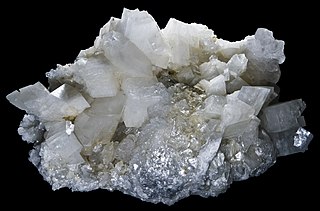
Dolomite is an anhydrous carbonate mineral composed of calcium magnesium carbonate, ideally CaMg(CO3)2. The term is also used for a sedimentary carbonate rock composed mostly of the mineral dolomite. An alternative name sometimes used for the dolomitic rock type is dolostone.
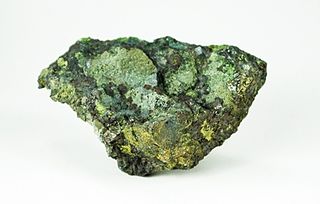
Trevorite is a rare nickel iron oxide mineral belonging to the spinel group. It has the chemical formula NiFe3+2O4. It is a black mineral with the typical spinel properties of crystallising in the cubic system, black streaked, infusible and insoluble in most acids.

Brownmillerite is a rare oxide mineral with chemical formula Ca2(Al,Fe)2O5. It is named for Lorrin Thomas Brownmiller (1902–1990), chief chemist of the Alpha Portland Cement Company, Easton, Pennsylvania.

Bentorite is a mineral with the chemical formula Ca6(Cr,Al)2(SO4)3(OH)12·26H2O. It is colored violet to light violet. Its crystals are hexagonal to dihexagonal dipyramidal. It is transparent and has vitreous luster. It has perfect cleavage. It is not radioactive. Bentorite is rated 2 on the Mohs Scale.

Ettringite is a hydrous calcium aluminium sulfate mineral with formula: Ca6Al2(SO4)3(OH)12·26H2O. It is a colorless to yellow mineral crystallizing in the trigonal system. The prismatic crystals are typically colorless, turning white on partial dehydration. It is part of the ettringite-group which includes other sulfates such as thaumasite and bentorite.

Ye'elimite is the naturally occurring form of calcium sulfoaluminate, Ca4(AlO2)6SO4. It gets its name from Har Ye'elim in Israel in the Hatrurim Basin west of the Dead Sea where it was first found in nature by Shulamit Gross.

Portlandite is a hydroxide-bearing mineral typically included in the oxide mineral class. It is the naturally occurring form of calcium hydroxide (Ca(OH)2) and the calcium analogue of brucite (Mg(OH)2).
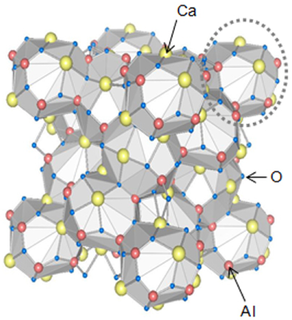
Chlormayenite (after Mayen, Germany), Ca12Al14O32[☐4Cl2], is a rare calcium aluminium oxide mineral of cubic symmetry.

Pseudowollastonite is a high-temperature mineral phase of CaSiO3 and is polymorphous with wollastonite. Its formula can alternatively be written as Ca3Si3O9. Other names include wollastonite 7T,ß-Wollastonite, and cyclowollastonite.
Yaakov Ben-Tor was an Israeli geologist.
The Hatrurim Formation or Mottled Zone is a geologic formation with outcrops all around the Dead Sea Basin: in the Negev Desert in Israel, in the Judaean Desert on the West Bank, and in western Jordan. It includes late Cretaceous to Eocene aged impure limestone along with coal bearing chalk and marl. The rocks have been subjected to pyrometamorphism resulting from combustion of contained or underlying coal or hydrocarbon deposits. The formation is named for exposures in the Hatrurim Basin which lies west of the Dead Sea.
Zadovite is an extremely rare mineral with formula BaCa6[(SiO4)(PO4)](PO4)2F. Together with its vanadium-analogue, aradite, zadovite occur in paralavas (type of pyrometamorphic rocks). Both minerals have structures similar to nabimusaite, and these three minerals occur in the Hatrurim Formation of Israel. Structure of all three minerals is related to that of hatrurite. Minerals combining barium, phosphorus and silicon together are scarce.
Pyrometamorphism is a type of metamorphism in which rocks are rapidly changed by heat, eg. coming from a rapidly emplaced extrusive or intrusive igneous rock or from a fossil fuel fire. The rocks produced by pyrometamorphism include buchite, clinker and paralava, formed due to melting and/or recrystallisation of sedimentary rocks. Both natural and anthropogenic examples of sites with active pyrometamorphism are known. One well-known area of natural pyrometamorphic rocks is the Hatrurim Formation. Xenoliths of sedimentary rocks trapped in volcanic lava may undergo pyrometamorphic transformation, as can some contact wallrocks. Anthropogenic pyrometamorphic rocks are found in burning coal-mining dumps. A great number of minerals, sometimes very rare, are found within these rocks. Of the silicate minerals, the typical ones are especially cordierite, indialite, fayalite, mullite, tridymite and cristobalite, and sekaninaite. Oxide minerals include corundum, hematite, hercynite, magnesioferrite, and magnetite. Some rare minerals typical of meteorites, like oldhamite, are also found in pyrometamorphic rocks.
Nabimusaite is a very rare mineral with formula KCa12(SiO4)4(SO4)2O2F. Its structure, as in case of similar aradite and zadovite, is a derivative of the one of hatrurite. Nabimusaite gives its name to the nabimusaite group. The mineral was found in a pyrometamorphic rock of the Hatrurim Formation, a site known for the natural pyrometamorphism. It is interpreted to have formed due to interaction of a precursor assemblage with sulfate-rich melt. Nabimusaite is potassium- and fluorine-analogue of dargaite.
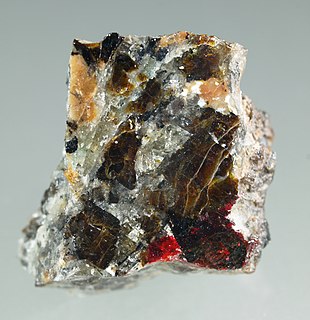
Gurimite is a rare mineral with formula Ba3(VO4)2. It is a simple barium vanadate, one of the most simple barium minerals known. It is named after its type locality - Gurim anticline in Israel. It has formed in the rocks of the Hatrurim Formation. Gurimite's stoichiometry is similar to that of copper vanadates mcbirneyite and pseudolyonsite. An example of other barium vanadate mineral is tokyoite.
Dargaite is a rare mineral with formula BaCa12(SiO4)4(SO4)2O3. It is the barium-analogue of nabimusaite, also differing from it in the lack of fluorine. It is one of many recently approved new minerals coming from the Hatrurim complex. Dargaite, as nabimusaite, is trigonal (space group R-3m).
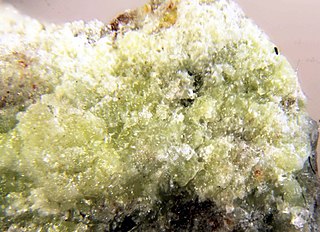
Hashemite is a very rare barium chromate mineral with the formula Ba(Cr,S)O4. It is a representative of natural chromates - a relatively small and rare group of minerals. Hashemite is the barium-analogue of tarapacáite. It is also the chromium-analogue of baryte, and belongs to the baryte group of minerals. Hashemite is stoichiometrically similar to crocoite and chromatite. Hashemite is orthorhombic, with space group Pnma. I was found together with chromium-bearing ettringite and an apatite group mineral in the Hatrurim Formation, known for the occurrence of rocks formed due to natural pyrometamorphism. Hashemite is named after the Hashemite Kingdom of Jordan.
Hexacelsian is a rare barium silicate mineral with the formula BaAl2Si2O8. It was discovered in the Hatrurim Basin in Israel, where the Hatrurim Formation of rocks formed due to exposed pyrometamorphism.

Shulamit Gross was an Israeli mineralogist and geologist who studied the Hatrurim Formation.
The geology of Israel includes igneous and metamorphic crystalline basement rocks from the Precambrian overlain by a lengthy sequence of sedimentary rocks extending up to the Pleistocene and overlain with alluvium, sand dunes and playa deposits.
References
- ↑ "Stracherite".
- ↑ "Stracherite | Carbon Mineral Challenge". mineralchallenge.net. Retrieved 2017-09-04.
- ↑ "Stracherite: Stracherite mineral information and data". www.mindat.org. Retrieved 2017-09-04.